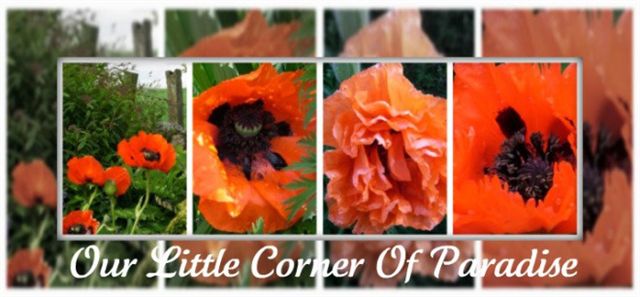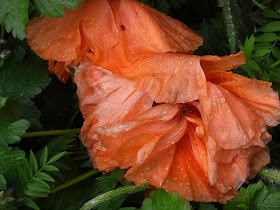Raindrops on poppies is also a common sight in the Barleycorn garden, for without the much-needed rain, my garden would not look as vibrant and lush as it does, and, never more so, than in the month of June. Even in their 'going over' period, I find beauty in the crumpled, frilly, translucent petals, and the discarded black anthers lying on the ground.
As far as I'm concerned the garden has to be a complete sensory experience, with smell coming to the fore in the Summer months. With that idea in mind, I grow a climbing Bourbon rose, called Rosa Zepherine Drouhin, outside one of the bedroom windows, so that its heady perfume fills the air on warm June days in particular. This year we have been blessed with a profusion of blooms. For me, this is a huge bonus as it is so difficult to grow roses in these parts as we are 225 metres above sea-level, with frequent winds blowing across the landscape.
Papaver Orientalis, Red Oriental Poppy
'Red and green should never be seen', goes the old adage. But, I love the combination. Green goes with everything as it is a perfect foil. With flowers as big as dinner plates, translucent petals for light to dance upon, ephemeral poppies add a touch of sophistication and glamour to the garden in Summer. I love the finely-cut, fern-like, hairy green foliage and the silky-textured, crepe paper petals of the ballgown flowers. You could be forgiven for thinking that the stunning blooms they produce would be difficult to grow, but nothing could be further from the truth.
Zygoptera, Red Damselfly
Red, blue and green damselflies flit around the ponds in June, adding a magical touch to the garden. With their two pairs of translucent, gossamer wings folded along their abdomen, they measure about 30mm in length. The adults feed on small insects and their larvae live on aquatic insects before emerging, after one year, as adults. I regard them as the fairies of the garden and find them very attractive to watch on sunny afternoons. Is anything more redolent of Summer?
Pots Of Salad Crops
It's amazing how many pots of plants can be grown from one bag of potting compost and a few packets of seeds. I also grow a few raspberry canes in pots, though I grow my strawberries in beds. Is there anything more exciting than eating one's home-grown produce, whether it be for a few weeks or a few months of the Summer?
Papaver Orientalis Turkenlouis, Oriental Poppy Curlylocks
Turkenlouis has to be the loudest Oriental poppy I grow. I love its serrated edges, the double-frilled petals and how they always hold their heads open to reveal the enormous seedbox and the black anthers. I grow it beside a yellow hemerocalis for contrast.
Hosta Sieboldiana
Hosta Sieboldiana has large, deeply-ridged, heart-shaped leaves of glaucus blue, and, when it rains, it holds enormous droplets of water. I find that most attractive. In all eighteen years here, the slugs and snails have never attacked my hostas...and I have many varieties of them. It is a dramatic plant in any border.
Papaver Orientalis, Oriental Poppies By The Front Pond
Over the years, I have filled my cottage garden with so many plants, there is little room for weeds to grow. A few years ago, in Springtime, while the plants were still small, I covered the areas between the flowers with bark, as a weed suppressant. It also helps as a mulch in dry weather.
Taz, The Barn Cat, In The Back Garden
Along the back wall bordering the adjacent farmer's field, I grow a nectar border for insects and butterflies, which, in turn, feed the birds. Taz, one of the barn cats, likes to lie in wait for voles and shrews. Over the years, I have been chasing my tail trying to combat the fierce winds blowing down my taller flowers, such as delphiniums and aconites, that I decided upon a plan of action for the whole garden.
Geranium Psilostemon
For two days in the month of June, I go around the whole garden with canes of varying sizes and thin green wire and insert them as a defence barrier. It looks a bit like invisible mending, for only the sharpest eyes could detect where I have been. It has been most successful over the past few years, as everything is held upright till the end of the season and the paths are kept clear. Best of all, on wet days, it is possible to walk around the entire garden without wet plants brushing against one's legs. This tall psilostemon geranium would be flattened by our strong winds in a day if it were not held upright. I love its magenta-coloured flowers as well as its attractive foliage.
Housemartins At Barleycorn
This year our housemartins did not arrive till the first day of June. But, we are lucky to have them. Normally we have three pairs building in the three apexes of the house, sometimes with triple nests in each...this year, only one pair. They have friends who join them in the evenings when they wheel overhead, and, to our delight, swoop and dive across the ponds catching insects on the wing, along with their other friends, the swallows.
Chaerophyllum Hirsutum Roseum, Cow Parsley
Cow parsley is usually a plant of the wayside, but I like its habit and grow some in my nectar borders. I also have the garden cultivar - chaerophyllum hirsutum roseum - which has pale pink blossom. It needs to be in a mixed bed as it can easily take over if left in too big a space, but it pays its weight in gold as far as the bees and insects are concerned.
Ranunculus, Meadow Buttercup
Do you like butter? Again, because of happy childhood days spent making daisy and buttercup chains, I grow ranunculus beside my wild cornfield poppies. A garden, for me, has to contain dreams and evoke memories, making room for the wildflowers as well as the cultivars in order to create a sense of soul and romance. It must tell its own story.
Nectar Borders In The Back Garden
This photograph shows a section of the garden made up of nectar borders. But, without them, I would not have so many varieties of visiting bees, insects and birds, which, in turn, bring visiting mammals. I have often been asked which flowers are my favourites. If I must choose it is a toss-up between wild poppies and foxgloves. But, each flower in season is a favourite...so many hues, so much individuality, such a variety of perfumes, each with their own story.
Borage Officinalis, Borage
Another of my favourites is the borage. The wonderful blue, (though sometimes white or pink) five-petalled, star-shaped flowers hanging in profusion, the tall graceful way it grows, the hairy leaves...all are attractive to me, and so nectar-rich for the bees that beekeepers often grow this plant.
Cirsium Rivulare Atropurpureum, Ornamental Thistle
My cirsium grows between six and seven foot tall. It is a very elegant plant, very stately with amazingly large leaves, considering the thistle heads are relatively tiny. Again, the bees adore it, as you will see in the little video I have taken.
Papaver Orientalis, Oriental Poppies At The Stane Dyke Wall
Although we have fierce winds blowing across our open landscape, I love to stand at the fence and watch the wildlife across the field. Sometimes there are buzzards mewing overhead, or larks making my heart soar with their amazing songs. Perhaps that's why I love Vaughan Williams' The Lark Ascending so much. Barley is the main crop grown in the adjacent field...and I love to hear the wind through the barley and watch it making waves while the barley is still young enough to bend.
Lupins, Geraniums, Aquilegia
The lupins in this photo have the most exquisite perfume. I wish I could bottle its scent and open it on cold Winter days to remind me of summery June. Over the years I have grown so many varieties of aquilegias....and they seed all over the place, which is a bonus to me. They are so enduring and add their own magic to our cottage garden. I love their 'Granny's bonnets', as we call them hereabouts, and their form and foliage, which can vary between acid green and purple-green.
Yellow Flag Irises In Back Pond
Yellow flag irises, also known as Jacob's sword, are stately plants of wild ponds...and of our ponds too. Again, so reminiscent of my childhood days at my Granny's cottage, I couldn't bear to be without them, for, though they used to be a common sight in the wild, with so many of the farmers' ponds being drained for intensive farming methods, they are growing scarcer each year. One school of thought says they are the origin of the fleur-de-lis in heraldry.
Mixed Nectar Borders In Front Garden
These borders are in the front garden. One whole bed contains varieties of geraniums, which flower for months on end, and if cut back, return with a final flush in September. I find the geranium a 'must' as they are easy to look after being disease-free, and bloom for long periods of the Summer.
Rosa Glauca, Rose
Lastly, I have chosen to show you my rosa glauca, the foliage of which is a wonderful shade of grey-purple with purplish-red stems. I am always told they do not do well in exposed windy sites, but, for some reason, they do well for me. Apart from the attractive cerise-pink flowers, in Autumn they have unusual wine-red fruits which feed the birds. The photo is well worth enlarging to see all the amazing tones in the foliage....and to spy the sweet little insect on the flower. The birds eat the fruit and leave me many seedlings scattered around the garden. I pot them up and grow some for myself, some to sell at garden fayres and some to share with friends and fellow gardeners.
xxxxxxx
The little film below was taken over a few days in June, and is made up of many little videos. If you turn up the volume you will hear the wonderful birdsong and the buzzing of the bees, the winds blowing and cars passing by, as people go about their daily business. It lasts for nine and a half minutes, so, if it sticks a bit, please be patient. The music, which plays through twice, is Thais' Meditation by Massenet. Enjoy!
xxxxxxx
If you click to enlarge each photo, you will find when the photo was taken, and the botanical name as well as the common name of each plant.
































